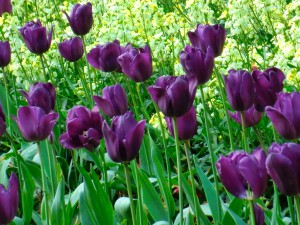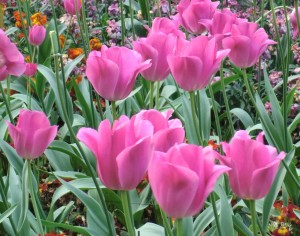Planting Spring Bulbs
Planting Spring bulbs
Fall is the ideal time to plant spring blooming bulbs. They can be planted as late as November-December before the ground freezes. Temperatures 35-50F degrees for 8-12 weeks will give them time to develop a good root system. 

Here is a quick planting guide
-When buying bulbs, check for quality. Be sure they are firm without soft spots or white mold.
-Bulbs need a light, well-drained soil or they will rot. For heavy, clay soil, incorporate organic materials such as peat moss or compost to improve drainage.
-They do not require fertilizer but will perform better when fed. Work up the soil and add bulb booster or a 5-10-10 fertilizer for vigorous future growth. The bulb should have no contact with the fertilizer, as it will burn developing roots. You can put bone meal in the bottom of the hole. Once planted, sprinkle bulb fertilizer on top of the backfilled soil in the fall or spring. If you don’t fertilize at this time, the best time is right after bloom (12-12-12 or 5-10-5).
Mulch planted bulbs after the ground freezes to protect from freezing/thawing cycle and remove in the spring.
–Planting depth
A general rule for tulips and daffodils is 3 times the diameter of the bulb. Cover small bulbs such as scillas, grape hyacinths, snowdrops with 2 inches of soil and large bulbs 6-8 inches. Other bulbs may vary a bit. Check package directions. In warmer climates bulbs can be planted 2 inches shallower.
-Plant pointed tip up, if not sure plant the bulb on its side, it will find its way up. 
Protect from animals
If you have problems rabbits, squirrels or chipmunks digging up your bulbs, here’s what you can do.
When planting cover the bulbs with half the soil, then cover place chicken wire and fill in with the remaining soil (at least 1 inch). The chicken wire will keep the critters from digging up the bulbs.
Plant less desirable bulbs such as allium, camassia, chionodoxa forbesii ‘Pink Giant’, colchicum ‘Waterlily’, eranthis (winter aconite), fritilaria, galanthus nivalis(snowdrops) muscari (grape hyacinths) and scilla siberica, which aren’t as tasty. Animals won’t bother daffodils or hyacinths, as they don’t taste good and are poisonous.
Hi, is there any way for growing tulip bulbs in the tropics ?
reblooming potted tulips
I live in Chicago and found a bunch of tulips that have passed their blooming period and were clearanced. I bought a ton of them. Is it too early to plant them in Chicago? What do I do with the yellowing leaves? Should I remove them or plant them with the bulb?
When to plant canna lily
Hi, I planted about 30 canna lilly bulbs last week and now its snowing. I live in michgan zone 6. Do my bulbs have a chance? What should I do?
I just bought a ton of bulbs….I live in Minnesota, zone 4. We could even have a couple of inches of snow this weekend. I have peony, iris and glads. Can I plant them now? They are starting to sprout in the bags but appear to be very fresh and healthy.
Secondly, will they bloom this year?
I live in zone 7 and I was given a big bag of daffodil bulbs on April 1. The green stems remain on the bulbs and the flowers have dried up. I’d like to plant them immediately in my yard rather than store them until next year. Is that a good plan?
Last years leftover Bulbs
hi i had some left over bulbs from last year and decided to plant them indoors since they were still firm and not rotted, also they had no mold on them. After i had planted them about a week later one had already begun to sprout, which i was excited for but it confused me why there was only one sincei had planted 50. so i sifted through the soil to look at the other bulbs and found that they now had a klittle bit of green mold on the tunic, or outer layer. but the bulbs were still very firm. i then thought that maybe they had not gotten enough water the first time i had watered them so i watered them again. after doing this and doing some research online i now wonder, is the extra water going to make the mold worse? they were planted in pots so that i can transplant them outside when it begins to get warmer…should i take them out of that soil and put them in new dryer soil or just let it be? i also found that some were putting the bulbs in some bleach, can you dig them up and do that and then replant them again? i am so confused…please help me.
i have got 3 chinese lanterns which way do i plant them they are shaped like a horse shoe is it the moon shape in the muck or the tails.
I’m from Chandler Texas. I’m not sure what zone I’m in now but we do get to where sometime between 60 to 75 degrees. I’m thinking about planting lilies and some butterfly bushes in my front yard lanscape but in the shade area and little of light filter and it now April 16, is it to late to plant it?
i bought a blue hyacinth plant at the store.when is the best time to transplant it into my garden?do i have to wait until the fall?or can i plant it while its blooming and pretty?
We planted bulbs this fall around a new home. When the cold weather set in we used leaves and pine straw to mulch because the compost we started had not had time to mature. The big snow has melted and we have had three warm days. Of course I had to take a look and there are all ready shoots coming up. I am worried about how moist the mulch is after all the snow and wondering if I should remove it and try to find something dryer to remulch with. There can be no way we will not have a few more freezes and the new shoots being up I am afraid I will loose them and lose the ones that are still dormant and seem to be too moist right now.
I want to plant tulips in containers. Should the pots be left outside (Zone 7) or placed in an unheated garage?
Dona
Transplant Iris
SHOULD I TRIM MY IRIS’S AFTER BLOOMING? & WHEN SHOULD I PULL UP SOME BULBS TO REPLANT IN A DIFFERENT AREA FOR NEXT YEAR?
THANK YOU
What can I do with the small bulbs that grow off the mother bulbs of tulips?
We have inherited extensive bulb plantings from the previous homeowner. One species of yellow daffodil has seemed to mutate over the years, producing very bizarre looking flowers, sort of like a double daffodil with no trumpet. We dug up the bulbs – they looked normal – separated them and replanted them – that didn’t help, even more of them seem to be turning into this bizarre phenotype. Any ideas? Is the soil chemistry wrong? Do they just get old and weird (not unlike us humans….)?
Can I pull up the tulip and buttercup bulbs and save them? If so, how do I need to store them for fall planting? Thanks.
hey , I’m writing from the Poconos, PA , I just built a flower bed for my wife and planted some daffs , tulips and other stuff. And now they are all dying because of the end of the season am I supposed to take the flower head off and leave them so they will come back next year? And also can I put anything else there so it looks pretty for her the rest of the summer?I appriciate it.thanks, Frank
I live in zone 5 and planted my bulbs mid November. I noticed early this week they are starting to pop up through the ground! We’ve had mild weather so far this winter. What will happen to my plants? What will happen in the spring when they are to bloom?
I discovered a bag of tulips I had misplaced, also a bag of daffodils, a couple of allium and one lily. I live in zone 2B, it is mid November, and the ground is now frozen to a depth of at least 6 inches. Is there any way I can keep these bulbs over and plant them later? Thanks
I’ve just received 100 planting bulbs, it’s still 80-90 degrees in early October when should I plant them?
My husband and I came a across a flower garden while cleaning up brush on our piece of property. Right now all we saw were daffodils that are blooming and looks like Irises coming up and maybe a few tulips?.however?. once we removed the brush from around the daffodils, the next day they started to fall over and turn yellow. What would cause this? Since the other daffodils that have been coming up for a long time in my yard and seem to be blooming just fine.
Kim
Bought lots of bulbs from a catalog.BIG mistake. They came with lots of fuzzy green mold. I dusted them with fungizide but then the snows came and it was too late to put them in the ground. HELP. Lots of bulbs and the snow has ceased. Should I plant them and see what happens? Varieties are tulips, lilies and mostly springlike. Will they come up next spring? Thanks for your help.
My daughter bought a beautiful potted daffodil, hoping to keep it in her room. Within days, all the flowers died and the plant generally looks terrible. She tried finding info on the web, so I told her I would ask you and see what we could do for this poor plant!
My daughter is getting married the end of May. She wants tulips for her wedding. When is the best time to plant the bulbs in order to get tulips to come up around that time?
I just bought a lot of bulbs at Home Depot. They say to plant between Sept. and Dec. Even though it is Sept 12, it is still 90degrees in Zone 7. Should I wait until it’s cooler? Thanks.
I live in zone 5. Can I plant bulbs that are to bloom next season now, or in the fall?
I’m a little confused about sun preference on plants. full sun I get but partial shade, and partial sun have me a little confused. If the sun peeks through most of the day on a spot but never really is sunny is that partial shade, or partial sun. Please explain, and thank you for this sight
I’m a new bulb person and I live in zone 5. my question is do I plant bulbs even after their blooming time or do I have to store them
I live in a zone 4 and I just purchased some potted bulbs -tulips and dafodils, they are just starting to sprout is it safe to plant them outside yet ?
A fascinating site. I have a question. Is there such a thing as a Christmas bulb, i.e., a bulb planted at Christmas or earlier that will either sprout or produce a bloom by Christmas.